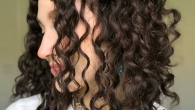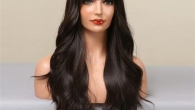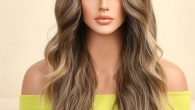
Monofilament Wigs: The Epitome of Comfort and Realism
Monofilament wigs have become increasingly popular among wig wearers for their natural look, breathability, and comfortable wear. Unlike traditional wigs with a cap construction, monofilament wigs boast a unique feature: a sheer mesh section at the crown where individual hairs are hand-tied. This innovative design mimics a natural scalp, creating an incredibly realistic appearance.
Whether you’re seeking a confidence boost after hair loss or simply desire a versatile way to change up your look, monofilament wigs offer a solution that is both beautiful and practical. This comprehensive guide delves into everything you need to know about monofilament wigs, from exploring the benefits and different types to choosing the right one for you and maintaining it for long-lasting wear.
Unveiling the Secrets of Monofilament Wigs
At the heart of a monofilament wig lies the monofilament top, a fine mesh material that replaces the traditional wig cap construction at the crown. This mesh allows for the individual hairs to be hand-tied, replicating the natural growth pattern of hair on the scalp. This innovative technique creates several advantages over traditional wigs:
- Natural Appearance: The monofilament top provides a realistic scalp illusion, especially when the wig is parted. The hand-tied hairs seamlessly blend with your scalp, making it difficult to distinguish the wig from natural hair.

- Comfort and Breathability: The sheer mesh material is lightweight and breathable, allowing for better air circulation. This can significantly enhance comfort, especially during extended wear.
- Versatility in Parting: Unlike traditional wigs with a pre-determined parting, monofilament wigs offer the freedom to part the hair in any direction you desire. This allows for greater styling flexibility and a more natural look.
A Tapestry of Options: Exploring Different Types of Monofilament Wigs
The world of monofilament wigs offers a variety of options to cater to your specific needs and preferences. Here’s a breakdown of some popular types:
- Full Monofilament Wig: As the name suggests, these wigs feature a monofilament top that covers the entire crown area. This offers maximum parting flexibility and a highly realistic scalp appearance.
- Monofilament Part Wig: These wigs have a monofilament section only at the parting area, allowing for parting versatility in a specific location. The rest of the wig cap might be made from a different material like lace or weft.
- Monofilament Crown Wig: This type features a monofilament section solely at the crown, providing a natural look at the top of the head. The remainder of the wig cap usually consists of a wefted construction.
The type of monofilament wig you choose depends on your desired level of parting flexibility, budget, and personal preference.
A Material Matchmaker: Human Hair vs. Synthetic Fiber in Monofilament Wigs
Monofilament wigs come in two primary materials: human hair and synthetic fiber. Each material offers distinct advantages and considerations:
-
Human Hair Monofilament Wigs:
- Pros: Provide the most natural look and feel, can be styled with heat tools for versatile styling options, and tend to last longer with proper care.
- Cons: Generally more expensive than synthetic wigs, require more maintenance, and are more susceptible to tangling.
-
Synthetic Fiber Monofilament Wigs:
- Pros: Typically more affordable, require minimal maintenance, and hold their style well, making them a convenient option.
- Cons: May not look as natural as human hair, cannot be styled with heat tools, and may have a shorter lifespan.
The ideal material for you depends on your budget, lifestyle, and styling preferences. If achieving the most natural look is your top priority, human hair might be the better choice. However, if you value convenience and affordability, a synthetic fiber monofilament wig could be a suitable option.
Finding Your Perfect Fit: Selecting the Right Monofilament Wig
With a plethora of monofilament wigs available, choosing the right one can seem daunting. Here are some key factors to consider:

- Face Shape: Certain wig styles can flatter your face shape more than others. Consider consulting with a hairstylist specializing in wigs for personalized advice.
- Hair Color and Style: Opt for a wig color that complements your skin tone and natural hair color. Think about the desired style – whether it’s a short and sassy pixie cut or long, flowing waves.
- Cap Size: Monofilament wigs come in various cap sizes to ensure a comfortable and secure fit. Measure your head circumference to determine the right size for you.
- Material: As discussed earlier, consider your budget, lifestyle, and desired level of realism when choosing between human hair and synthetic fiber.
Maintaining the Magic: Caring for Your Monofilament Wig
Just like your natural hair, monofilament wigs require proper care to maintain their beauty and longevity. Here are some essential tips:
- Gentle Cleansing: Wash your wig regularly with a shampoo formulated specifically for wigs. Avoid harsh chemicals and hot water, as they can damage the wig fibers and the monofilament top.
- Conditioning Love: Use a conditioner designed for wigs to replenish moisture and prevent dryness and tangles.
- Detangling with Care: Detangle your wig gently with a wide-tooth comb while it’s wet and coated with conditioner. Start at the ends and work your way up to the roots to avoid pulling or snagging.
- Air Drying is Best: Allow your wig to air dry on a wig stand or mannequin head. Avoid using direct heat sources like blow dryers or curling irons, especially with synthetic fiber wigs.
For human hair monofilament wigs, you can use heat styling tools on a low to moderate setting with a heat protectant spray applied beforehand. However, it’s always best to consult a hairstylist specializing in wigs for heat styling recommendations specific to your wig.
The Art of Application: Mastering Monofilament Wig Installation
Putting on a monofilament wig can seem like a challenge at first, but with practice, it becomes a breeze. Here’s a basic guide to get you started:

- Prep Work: Braid down your natural hair to create a smooth, flat surface. Secure the braids with bobby pins.
- Wig Cap Magic: Put on a wig cap to further secure your natural hair and protect your scalp.
- Customizing the Lace (Optional): You can slightly trim the lace front (if applicable) for a more natural hairline.
- Applying Adhesive: Use a wig adhesive or lace glue specifically formulated for monofilament wigs. Apply the adhesive sparingly along the lace front or the perimeter of the wig cap, following the manufacturer’s instructions.
- Positioning the Wig: Carefully place the wig on your head, aligning the hairline with your natural hairline.
- Securing the Wig: Gently press down on the wig to secure it in place. You can use wig clips or headbands for additional security.
There are numerous video tutorials available online that offer a more visual demonstration of the application process.
Unleashing Your Confidence: The Allure of Monofilament Wigs
Monofilament wigs offer a world of possibilities for those seeking a comfortable, natural-looking, and versatile way to express themselves. Whether you’re experiencing hair loss, undergoing medical treatments, or simply looking to explore different hairstyles, monofilament wigs provide a solution that is both beautiful and practical.












Leave a Reply